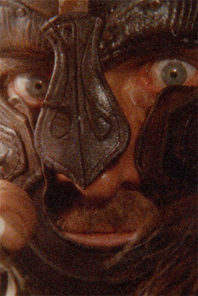
In Hrafninn flýgur, or When the Raven Flies, a young Irishman avenges the kidnapping of his sister. This is a tall order for him because he’s a young man living in Medieval times. A time when Viking raids like the one he experienced happen all the time. This film could have added more to its 113 minutes by showing all the places he went. But thank God it just showed us landing at his final destination. And when he lands, the film shows a discombobulated mixture of the Icelandic conception of what an Irishman is like. He has a cane like St. Patrick and a bow and arrow like Robin Hood. He takes down the raiders who enslaved his sister and many more innocent women like her.
Director Hrafn Gunnlaugsson’s film is goofy and doesn’t age well. Its ketchup red effects can remind audiences of films like Ladyhawke and The Princess Bride. But those films came out a year or so after this one. Either there’s something in the air in the 80s that made everyone want to make Medieval synthesizer films. Or that its inclusion in TIFF’s Icelandic retrospective proves how much of a trendsetter the country really is. It also helps to look at Gunnlaugsson’s influences are. TIFF draws a through line between this and Bergman’s early work. A professor also noted Gunnlaugsson as a self-declared disciple of John Ford. This makes the revenge stuff look like what would happen if a straight man did campy Western films.
This film’s hero, if you can call him that, is Gest (Jakob Þór Einarsson). His plan, after the initial cool kills, is to make the slave poacher Vikings distrust each other so much that they kill each other without him having to lift another finger. One of these Vikings is Erik (Flosi Ólafsson), who wants to return to Norway and rule that country. The casting of the older Ólafsson, compared to the young Einarsson, shows that, just like many films, virtue is all about looks. Anyway, Erik’s departure, however, might show that he’s running off with the money that both he and Thord (Helgi Skúlason) share. Both of them kidnapped Gest’s sister (Edda Björgvinsdóttir) and Thord married her eventually, producing young Einar (Gottskálk Dagur Sigurðarson).
Hrafninn flýgur seems like an adaptation of a Norse epic, and there are benefits to telling that story in the cinematic medium. My experience with epic poetry has its limits. Although from what I know, there’s a lot of archetypal characterization and action in that medium. Film adds a complexity to these characters, which produces problematic results. Thord is a fearsome sleazeball, yes, but it also shows him as a family man. It helps that his family has dangerous enemies and he protects them. Which again, adds to how this film doesn’t age well. Certain audiences in 2019 might scoff at his characterization and say “So other than the fact that he financially benefits from sexual slavery and that he kills people, he’s a nice guy”.
As much as Hrafninn flýgur fails its supporting characters, it tries not to make the same mistakes with its protagonist. Other than Ford, Gunnlaugsson’s other influences include Leone and, by association, Kurosawa, and it shows in how Gest seems like a younger version of Eastwood and Mifune. And his youth is an asset here, the film contrasting that quality against the God fearing hypocrisy of the people on his kill list. Their God fearing ways add stakes to Gest’s struggles, since these Norse Gods are apparently telling Thord to sacrifice Einar. Although one way to interpret this plot twist is that sacrificing Einar is tangentially Gest’s idea. This plot twist on top of many plot twists show that the struggle between Gest and Thord are both generational and ideological.
The film is wise in deciding not to depict Gest as a pure Irishman. They could have turned him into a Christian fundamentalist or make him speak Gaelic or English once in a while. And there’s something fascinating about his Viking qualities, like believing in Thor while taking advantage of the other characters’ Norse religion against them. All of these parts are within a brooding and likable protagonist. But they don’t make for an interesting whole. We can say the same for the film, which initially starts out as a “kill list” film. But it turns into one into one about Viking business and religious intrigue, and the introduction of these latter points drains the film of its early energy.
And unlike the films it’s referencing, this one keeps either introducing new characters or new qualities within its core characters. Thord’s brother (Egill Ólafsson) comes into the scene, and of course they don’t bother naming him. He’s sadistic, unlike Erik or Thord, finding joy in torturing Gest. There are a few reasons that Gest is in this vulnerable position. One is to make Gest into a Jesus figure. But the main one is that Gest’s sister, instead of allying with the brother rescuing her from sexual slavery, shows symptoms of Stockholm syndrome and betrays him. It doesn’t help that Gest’s sister is the only female here with more than one scene. What’s worse is that the film decides to make her a ‘disloyal female’.
In making this film, Iceland tells its Viking stories instead of Hollywood doing so, and this kind of agency is admirable. We can also give it credit for starting or continuing a trend where audiences in the 80s found an interest in Medieval films. And sure, the films in this program have its aesthetic of either Börn náttúrunnar‘s earthy greens or Mýrin‘s neon green, but the earth tones are here a surprising delight. But just like the first draft or a second draft of a sub genre, the end result is clunky. What’s worse is that it propagates paternalistic values and tries to pass off terrible characteristics as complexity. Thank God that films after it try to question and subvert this early example.

